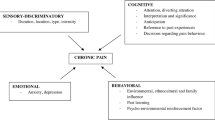Abstract
A comprehensive assessment of cancer pain is the first and perhaps most important step toward pain relief. Yet, this assessment is frequently neglected in patients with cancer pain. This paper addresses five important aspects of cancer pain assessment: (1) What constitutes cancer pain assessment? (2) Why is it important? (3) Why is it frequently overlooked? (4) How can a cancer pain assessment program be implemented? (5) What changes can be expected as a result of routine cancer pain assessments? The fundamental assumptions underlying this discussion are that health-care providers must understand the intensity of their patients' pain and the likely etiology of that discomfort to direct an appropriate diagnostic evaluation and to initiate and evaluate the success of therapy. Instituting a routine pain assessment program need not be difficult. The recommended procedures must be simple, quantifiable, relevant, and recorded in the medical record. Routine pain assessment will promote a heightened sense of awareness and responsibility about cancer pain issues in health-care providers, improved communication between the patient and the healthcare provider, the development of cancer pain quality-assurance programs, and improved care for patients with cancer and pain.
Similar content being viewed by others
References
Bruera F, McMillan K, Hanson J, et al (1989) The Edmonton staging system for cancer pain: preliminary report. Pain 37:203–209
Chapman CR, Casey KL, Dubner R, et al (1985) Pain measurement: an overview. Pain 22:31
Choiniere M, Melzack R, Girard N, et al (1990) Comparisons between patients' and nurses' assessment of pain and medication efficacy in severe burn injuries. Pain 40:143–152
Cleeland CS (1990) Assessment of pain in cancer. In: Foley KM, Bonica JJ, Ventafridda V (eds) Advances in pain research and therapy, vol 16. Raven Press, New York, pp 47–55
Fishman B, Pasternak S, Wallenstein S, et al (1987) The Memorial pain assessment card: a valid instrument for the evaluation of cancer pain. Cancer 60:1151–1158
Foley JM (1979) Pain syndromes in patients with cancer. In: Bonica JJ, Ventafridd V (eds) Advances in pain research and therapy, vol 2. Raven Press, New York, pp 59–75
Graham C, Bond SS, Gerkovich MM, et al (1980) Use of the MCGill pain questionnaire in the assessment of cancer pain: replicability and consistency. Pain 8:377–387
Grossman SA (1993) Undertreatment of cancer pain: barriers and remedies. Support Care Cancer 1:74–78
Grossman SA, Weissman DE, Wang H, et al (1990) Early diagnosis of spinal epidural metastases using out-patient computed tomographic myelography. Eur J Cancer Clin Oncol 26:495–499
Grossman SA, Sheidler VR, Sweden K, et al (1991) Correlation of patient and caregiver ratings of cancer pain. J Pain Symptom Manage 6:53–57
Grossman SA, Sheidler VR, McGuire DB, et al (1992) A comparison of the Hopkins Pain Rating Instrument with standard visual analogue and verbal descriptor scales in patients with cancer pain. J Pain Symptom Manage 7:196–203
Kremer EF, Atkinson JH, Ignelzi RJ (1982) Pain measurement: affective dimensional measure of the McGill pain questionnaire with a cancer pain population. Pain 12:153–163
Max M (1991) American Pain Society quality assurance standards for relief of acute pain and cancer pain. In: Bond MR, Charlton JE, Woolf CJ (eds) Proceedings of the VI World Congress on Pain. Elsevier, Amsterdam, pp 185–189
Melzack R (1975) The McGill pain questionnaire: major properties and scoring methods. Pain 1:277–299
O'Brien J, Francis A (1988) The use of next-of-kin to estimate pain in cancer patients. Pain 35:171–178
Stjernsward J, Teoh N (1990) The scope of the cancer pain problem. Adv Pain Res Ther 16:7–12
Twycross RG (1978) Relief of pain. In: Sunders CM (ed) The management of terminal disease. Chicago Yearbook Publishers, Chicago, p 65
Twycross RG (1984) Incidence of pain. Clin Oncol 3:5
Williams CR (1988) Toward a set of reliable and valid measures for chronic pain assessment and outcome research. Pain 35:239–251
World Health Organization (1990) Cancer pain relief and palliative care. WHO Tech Rep Ser 804:23–41
Author information
Authors and Affiliations
Rights and permissions
About this article
Cite this article
Grossman, S.A. Assessment of cancer pain: a continuous challenge. Support Care Cancer 2, 105–110 (1994). https://doi.org/10.1007/BF00572091
Issue Date:
DOI: https://doi.org/10.1007/BF00572091




